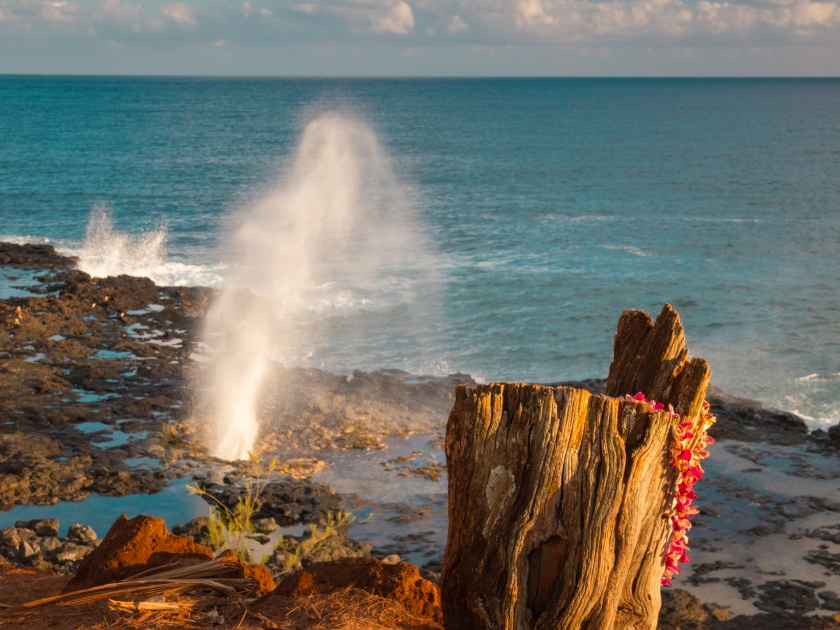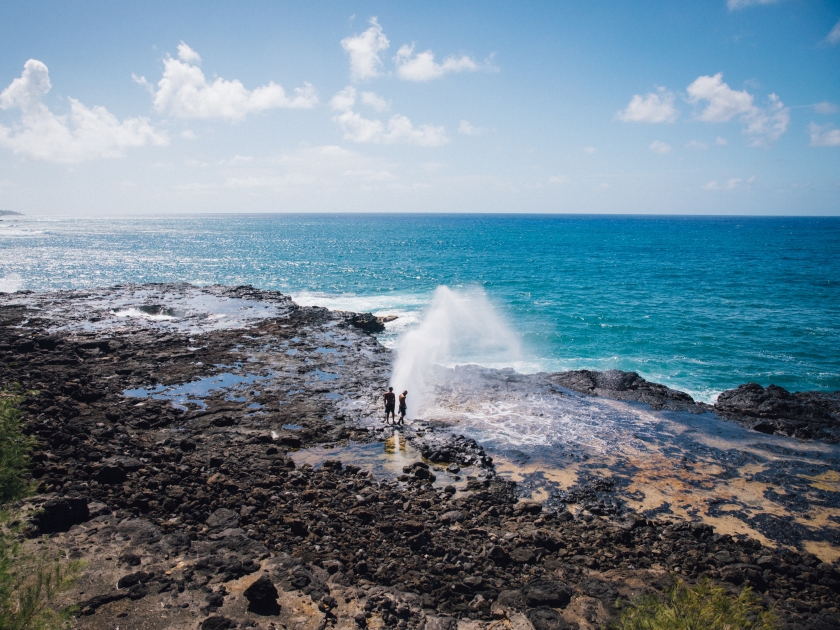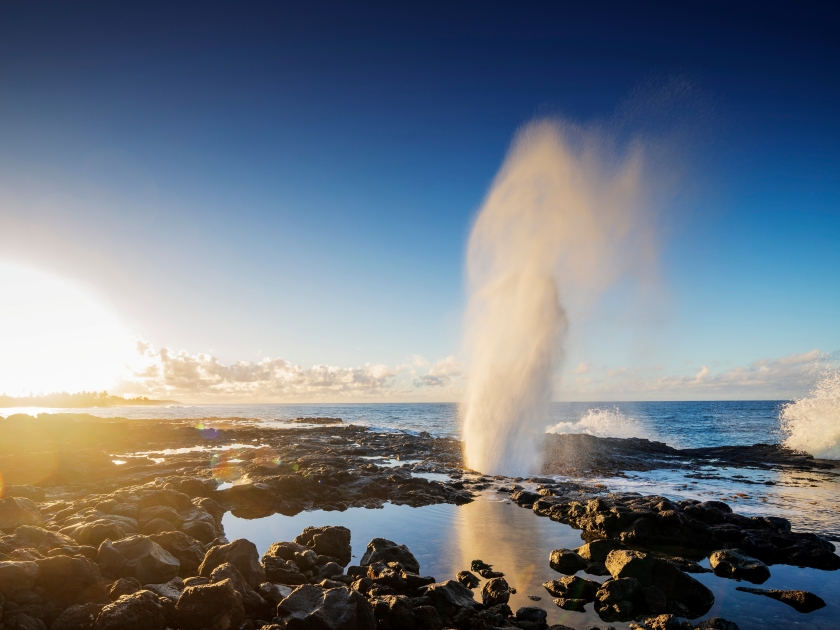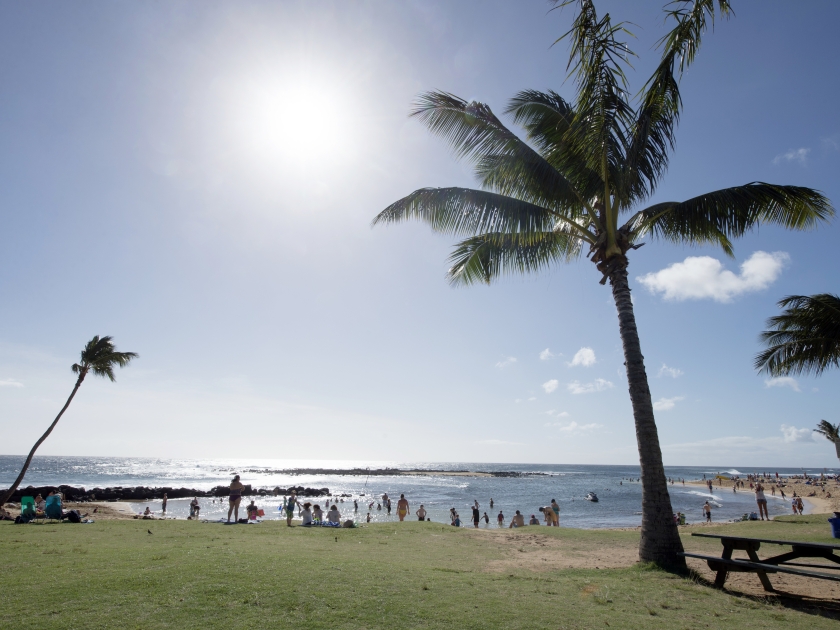Spouting Horn, located on Kauai’s southern coast, is one of Hawaii’s most captivating natural wonders. This famous blowhole shoots water high into the air as ocean waves rush through lava tubes, creating a unique spectacle that draws tourists year-round. Known for its mesmerizing water spouts and distinctive hissing sound, Spouting Horn offers visitors a glimpse of nature’s raw power and beauty. This guide will explore the best times to visit, the cultural legends behind it, and tips for capturing its stunning displays on camera.
Highlights
- Witness the dramatic blowhole as seawater shoots up through a lava tube, creating a powerful spray that can reach up to 50 feet high.
- Enjoy sweeping views of the coastline from the viewing platform.
- The rugged beauty of the lava rock formations and the endless Pacific Ocean provide perfect photo opportunities.
- Keep an eye out for sea turtles and dolphins that are often seen near the blowhole.
- Browse the nearby local vendors for unique handcrafted items and Hawaiian souvenirs.
- Spouting Horn is easily accessible and can be combined with other nearby attractions, making it a quick and rewarding stop on your Kauai itinerary.
History

Spouting Horn, located on the southern shore of Kauai, is one of Hawaii’s most captivating natural attractions. This impressive blowhole is formed by the ocean’s relentless force, as waves crash against the lava rock, forcing water through a narrow tube. The result is a towering spray of seawater that shoots high into the air, mimicking the sound of a spouting horn. Visitors from around the world are drawn to this unique display of nature’s power and beauty.
The Legend of the Mo’o: A Hawaiian Tale
Spouting Horn is steeped in Hawaiian mythology, with one of the most well-known legends involving a giant lizard, or mo’o, that once protected the coastline. According to the tale, a brave young man named Liko ventured into the waters guarded by the mo’o. The creature attacked, but Liko escaped by swimming into a lava tube, trapping the lizard inside. To this day, it is said that the mo’o’s cries and roars can still be heard from the blowhole, adding a layer of mystique and cultural significance to the site.
Human Influence on a Natural Wonder
Although Spouting Horn is a naturally occurring blowhole, human activity has had an impact on the area. In the 1920s, a neighboring blowhole known as the Kukui’ula Sea Plume was destroyed using dynamite to prevent salt spray from damaging nearby sugarcane crops. This intervention altered the natural landscape, underscoring the delicate balance between human industry and the preservation of natural marvels. Fortunately, Spouting Horn remains intact and continues to awe visitors with its power.
At Present
Today, Spouting Horn is a must-visit destination for anyone traveling to Kauai. Whether you’re drawn by its stunning natural displays or intrigued by the rich folklore surrounding it, this iconic site offers a memorable glimpse into both the beauty of nature and the depth of Hawaiian culture.
What to Expect When Visiting

When visiting Spouting Horn, you’ll find a designated viewing area that offers a safe and clear perspective of the blowhole’s spectacular water spouts. Nearby lookout points provide additional vantage spots for photography and taking in the scenic ocean views. The site is equipped with convenient parking, making it easily accessible for all visitors. Benches and shaded areas allow for relaxation while enjoying the natural display, and there are restrooms available on-site to accommodate your needs during the visit.
Photography Tips

For the best photography opportunities at Spouting Horn, position yourself at the main viewing area where you can capture both the blowhole and the surrounding ocean scenery. Early morning or late afternoon offers softer lighting, while sunset adds dramatic colors to the sky and water, creating a stunning contrast with the water spouts. To enhance your photos, use a wide-angle lens to capture the entire landscape, and during sunset, adjust your settings to highlight the vibrant hues against the darkening backdrop for a truly breathtaking shot.
Tips for Visiting
- Parking: Ample parking is available near the viewing area for easy access.
- Bring Sun Protection: Wear sunscreen, hats, and sunglasses as the area can get sunny.
- Stay at a Safe Distance: Keep a safe distance from the blowhole to avoid any potential hazards from strong waves.
- Comfortable Footwear: Wear sturdy, comfortable shoes as the terrain around the viewing area can be uneven.
- Plan for a Picnic: Use the shaded areas and benches for a relaxing break, or pack a picnic to enjoy with ocean views.
- Check Tide Schedules: High tide often results in more dramatic water spouts, so plan your visit accordingly.
Best Times to Visit
The best times to visit Spouting Horn are early morning or late afternoon when the lighting is softer, and the crowds are lighter. These times not only offer better photo opportunities but also provide a more peaceful experience. Visiting during high tide can enhance the blowhole’s water spouts, making for a more dramatic spectacle. Sunset is another popular time to visit, as the vibrant colors of the setting sun create a beautiful backdrop for the water spray.
Nearby Attractions

While visiting Spouting Horn, take the opportunity to explore the nearby attractions for a full day of sightseeing. Just a short drive away, Poipu Beach offers pristine sand and excellent snorkeling, perfect for relaxing by the water. The nearby National Tropical Botanical Garden and Allerton Garden provide a peaceful retreat into lush greenery, where you can stroll among native plants and enjoy guided tours. These spots, combined with Spouting Horn, make for a well-rounded experience of Kauai’s natural beauty and charm.
Frequently Asked Questions (FAQs)
Spouting Horn is a natural blowhole on the south shore of Kauai, where ocean waves create a spout of seawater that can reach up to 50 feet high.
Spouting Horn is located in Poipu on Kauai’s southern coast, easily accessible via Spouting Horn Park.
The blowhole is caused by waves forcing water through a narrow lava tube, creating a powerful spout of water and a distinctive hissing sound.
Yes, visiting Spouting Horn is free, and it includes a viewing area where visitors can safely watch the blowhole in action.
The water spout at Spouting Horn can reach heights of up to 50 feet, depending on ocean conditions.
Yes, Spouting Horn is child-friendly, with safe viewing platforms that allow families to enjoy the natural spectacle from a distance.
How to Get There
By Car
To reach Spouting Horn by car, start by navigating Highway 50 on the island of Kauai. Head towards the southwestern coast, following the signs for Poipu. Once you arrive in the Poipu area, continue on Lawai Road until you see the signs for Spouting Horn. There is ample parking available near the viewing area, making it convenient to enjoy this natural attraction.
By Bus
For those opting to use public transportation, the Kauai Bus service offers routes that can get you near Spouting Horn. Check the schedule for the Poipu route, which typically stops at key locations in the area. Be prepared to walk a short distance from the nearest bus stop to reach Spouting Horn, as the bus may not drop you off directly at the site.
Catch the Wave of Wonder at Spouting Horn
Spouting Horn is more than just a natural wonder—it’s a dynamic dance of ocean power that enchants visitors with its unique water spouts and legendary charm. A trip here offers not just awe-inspiring sights but a gateway to exploring Kauai’s scenic treasures like Poipu Beach and the lush botanical gardens nearby. Make Spouting Horn the highlight of your Kauai adventure and discover how it beautifully ties together the island’s natural beauty and cultural richness.




